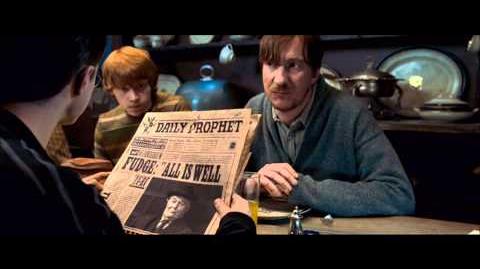
|
Warning!
Some content in this article is derived from information featured in Harry Potter and the Cursed Child, and, as such, spoilers will be present. |
- "Imagine that Voldemort's powerful now. You don't know who his supporters are, you don't know who's working for him and who isn't; you know he can control people so that they do terrible things without being able to stop themselves. You're scared for yourself, and your family, and your friends. Every week, news comes of more deaths, more disappearances, more torturing... The Ministry of Magic's in disarray, they don't know what to do, they're trying to keep everything hidden from the Muggles, but meanwhile, Muggles are dying too. Terror everywhere... panic... confusion... that's how it used to be."
- — Sirius Black regarding the First Wizarding War[src]
The First Wizarding War[1] was a major conflict with foundations as early as the 1940s, but officially beginning in 1970 and ending in 1981. It marked the original "reign" of the Dark Lord Voldemort.
The Dark Lord's rebellion occurred with the help of his Death Eaters, Dark wizards and witches who served him and brought terror to both Muggle and magical innocents. They were opposed by the Ministry of Magic and the Order of the Phoenix, an organisation founded by Albus Dumbledore that would play a crucial role in both of Voldemort's defeats.
Voldemort's first defeat took place on 31 October, 1981 at the hands of an infant Harry Potter. Shortly thereafter, all of his remaining Death Eaters were imprisoned, killed, or acquitted, bringing the war to an end.
History
Prelude
Birth of Lord Voldemort
- "Once, there was a young man who, like you, sat in this very hall, walked this castle's corridors, stepped under its roof. He seemed to all the world a student like any other. His name: Tom Riddle. Today, of course, he's known all over the world by another name."
- — Albus Dumbledore on Voldemort's early years[src]
The notorious Dark Wizard commonly known as "Lord Voldemort" was born Tom Marvolo Riddle on 31 December, 1926, in southern England, to Tom Riddle Snr, an affluent Muggle gentleman from an old family of Muggle squires considered the most locally prominent but unpopular land gentry within the Yorkshire village of Little Hangleton, and Merope Gaunt, a traumatised pure-blood witch disowned by the pure-blood supremacist House of Gaunt, an ancient yet impoverished wizarding family which tended to demonstrate mental instability caused by generations of inbreeding. Having eloped while Riddle Snr was influenced by a Love Potion, the couple caused a great scandal among the villagers over the common unpopularity (although for differing reasons) of the two families. But Merope grew tired of living such lie when pregnant months later, and thus lifted the bewitchment on her husband in hopes he would either return her feelings or stay for their child's sake. Instead, Riddle Snr fled back to Little Hangleton in disgust, leaving his wife in a state of depression in which she gave up the use of magic. Spending the rest of her life as a pauper on the streets of London, Merope sold a few stolen Gaunt heirlooms in order to survive, and died moments after giving birth to and naming her son. As a result, the orphaned Riddle was left to spend the first eleven years of his life in the Muggle-run Wool's Orphanage, where the coercive circumstances of his conception and lack of parental love likely contributed to his many early warning signs of psychopathy.
During this time, the secret wizarding world to which Riddle unknowingly belonged developed new levels of anti-Muggle sentiment. Around the time of his birth, for instance, the notorious Dark Wizard Gellert Grindelwald began launching his magical supremacist war on the European mainland, fueled by his quest to obtain all three of the legendary Deathly Hallows. With his army of followers and one of the Hallows, the Elder Wand (which he stole from celebrated wandmaker Mykew Gregorovitch), as protection, he aimed to overthrow the International Statute of Wizarding Secrecy and subjugate Muggles under a new world order run by wizards. In the 1930s, historian Cantankerus Nott anonymously published the Pure-Blood Directory, which listed the 28 remaining pure-blood families in Great Britain, including the Gaunts. Many of these families considered themselves superior due to their blood status and looked down on "blood traitors" and "Mudbloods".
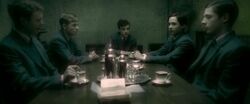
A picture of Tom Riddle with his first followers
Riddle was brought into the wizarding world in 1938 by Professor Albus Dumbledore, the renowned Transfiguration teacher at Hogwarts School of Witchcraft and Wizardry, who noticed the boy's apathy and selfishness but otherwise felt no greater concern for his flaws. The boy began attending Hogwarts himself later that year and was sorted into Slytherin House, where he proved to be an exceptionally gifted student. Although his unhealthy mental state worsened as he began his quest for domination, he simultaneously got better at concealing it and used his good looks and charm to ingratiate himself with his teachers (with the notable exception of Dumbledore) and classmates. Many of them were taken in by his charismatism, and by the start of his second year, Riddle was made leader of a like-minded gang of Slytherin boys known as the Knights of Walpurgis (consisting of Antonin Dolohov, Nott, Rosier, Mulciber, Avery and Lestrange). The members of this gang, whom all came from wealthy pure-blood families, were involved in a number of nasty incidents during their school years, though he was careful to never become implicated in any wrongdoing and was generally held as a model student.
Over time, Riddle grew obsessed with discovering his magical ancestry. He came to the conclusion that his father must have been a wizard because his mother suffered death, a mysterious and terrifying fate he assumed powerful witches and wizards could avoid. When he could find no trace of any Riddles with magical blood, he was forced to accept that his father was a "filthy Muggle" and that the magically powerful could indeed die. Enraged by this discovery, he rearranged the letters of his own full name ("Tom Marvolo Riddle") to give himself a new one: "I Am Lord Voldemort", which he used among his friends.
Heir of Slytherin
- Harry Potter: "You. You're the Heir of Slytherin. You're Voldemort."
- Tom Riddle: "Surely you didn't think I was going to keep my filthy Muggle father's name, did you? Keep the name of a man who abandoned my mother when he found out that she was a witch? No! I fashioned myself a new name, a name I knew wizards everywhere would one day fear to speak, when I became the greatest sorcerer in the world!"
- — Tom Riddle and Harry Potter in the Chamber of Secrets in 1993[src]
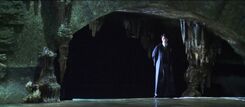
Tom Riddle standing in the Chamber of Secrets
Riddle finally found his magical ancestry in his fourth year when he used his middle name Marvolo (which was derived from his maternal grandfather Marvolo Gaunt) to discover the Gaunts and their descent from the Slytherin family. This explained that his exceptionally rare ability to speak Parseltongue made him the "Heir of Slytherin", rumoured to be the sole person who could open the legendary Chamber of Secrets. However, his most burning obsession remained the Chamber itself, the hidden entrance of which he spent the majority of his fifth year searching for despite most people insisting it was nothing but a myth. Finally, near the end of the year, he succeeded where countless others had failed by discovering the entrance in a girl's bathroom which led down into the sewers beneath Hogwarts Lake. Entering the chamber, Riddle encountered the millennium-old Basilisk living inside and confirmed his connection to the historical dark wizard that bred it with his commands, which it obeyed.
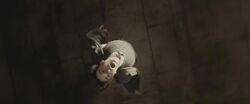
Tom Riddle creating a Horcrux for the first time during his sixth year at Hogwarts
On 13 June, 1943, Riddle unleashed the beast into Hogwarts to continue Slytherin's "noble work" of purging the school of Muggle-born students. Several were petrified and one named Myrtle Warren was killed. However, this prompted Headmaster Armando Dippet and the Hogwarts Board of Governors to discuss closing the school in the interest of safety. Faced with returning to the Muggle orphanage he so despised, Riddle abandoned the Chamber of Secrets and framed half-giant third year Gryffindor Rubeus Hagrid and his pet acromantula Aragog for the crimes. As a result, Hagrid was expelled with his wand snapped while Riddle was unjustly rewarded the Special Award for Services to the School. With his fear of death exacerbated by having stared it in the face, he used the murder of Myrtle to turn his school diary into his first Horcrux, the method to create which he feverishly researched in the Hogwarts Library's Restricted Section and learned from a copy of Secrets of the Darkest Art that was held there.[2]
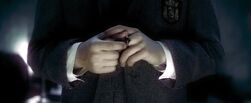
The ring in Tom Riddle's possession after he murdered his father and paternal grandparents
Around August, 1943, Riddle tracked down his Gaunt relatives to Little Hangleton, where his maternal uncle Morfin Gaunt gave him a biassed account of his father leaving his mother to die and abandoning him to the orphanage. In a desire for revenge, he entered the Riddle House and used the Killing Curse to kill his father alongside his Muggle grandparents, Thomas and Mary, then framed Morfin for the crimes by placing him under the influence of a False Memory Charm. As a result, Morfin was sentenced to life incarceration in the Dementor-infested wizard prison Azkaban (whereas, the Riddles' caretaker Frank Bryce was blamed, though not prosecuted, for the murders within the Muggle community) while Riddle stole the Gaunts' signet ring (which, unbeknownst to anyone at the time, contained another of the Deathly Hallows, the Resurrection Stone) and started wearing it as a trophy. Shortly afterwards, he returned to Hogwarts for his sixth year and discussed the theoretical possibility of creating six Horcruxes (thus splitting the soul into seven pieces) with Professor Horace Slughorn, the Potions Master and his Head of House, who was taken aback by Riddle's interest in such Dark Magic. Although reluctant at first, Slughorn nonetheless gave him an overview of such an experiment with the promise of keeping their discussion between only them. This apparently gave Riddle what he wanted to hear, and he used the murder of his own father to turn the ring into his second Horcrux.[3]
In 1945, Dumbledore, the only person who could see through Riddle's façade and thus the only one he feared, demonstrated his astounding magical mastery by defeating Grindelwald in a legendary duel and obtained ownership of the Elder Wand. Thus, the defeated Grindelwald was imprisoned for life in his own prison Nurmengard, and peace was restored to the wizarding communities of continental Europe. Around this time, Riddle graduated from Hogwarts and quickly applied for the position of Defence Against the Dark Arts professor, which had just been vacated by Galatea Merrythought. Dumbledore, now a world-famous household name, argued against having him on the staff, so Dippet ended up cordially rejecting Riddle on the basis of being too young. However, Riddle began developing an interest in the relics of the Hogwarts founders, and before leaving charmed the Grey Lady, the ghost of Ravenclaw House who was in life a member of the Ravenclaw family, to reveal where she hid Rowena Ravenclaw's diadem: a remote forest in Albania. So he travelled there and retrieved it from a hollow tree, using the murder of an Albanian peasant he encountered along the way to turn the diadem into his third Horcrux.[4]
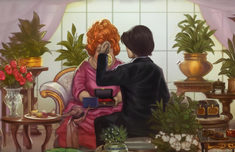
Hepzibah shows Slytherin's Locket to Tom Riddle. Hokey stands with the box containing Hufflepuff's Cup
When he returned to England, Riddle was offered several positions in the British Ministry of Magic, but turned them all down and began working at Borgin and Burkes, a dirty and disreputable Dark Arts shop in Knockturn Alley run by Caractacus Burke, which many believed was a waste of his talents. Tasked with smooth-talking people into parting with their possessions for far less than the actual cost, he used his position to learn more about the Dark Arts and form a one-sided friendship with Hepzibah Smith, a wealthy old antiques collector descended from the Hufflepuff family who was attracted to him. At some point between 1955 and 1961[5], Riddle visited her to negotiate the sale of a goblin-made suit of armour in her possession, which Hepzibah used as an opportunity to show him two of her most prized treasures: Helga Hufflepuff's cup and Salazar Slytherin's locket, the latter of which Riddle's mother sold to Burke after stealing it from the Gaunts years earlier. In a desire for gain, he used a little known poison to kill Hepzibah two days later, then framed her house-elf Hokey for the crime by placing her under the influence of another False Memory Charm. As a result, Hokey was convicted of accidental manslaughter while Riddle resigned his post at Borgin and Burkes and disappeared without a trace, using the murders of Hepzibah and a Muggle tramp to turn the cup and locket into his fourth and fifth Horcrux respectively.[6]
Immersion in the Dark Arts
Now going exclusively by Lord Voldemort, Riddle laid low and travelled around the world. Little is known of his activities during this period, though he explored the Dark Arts extensively, studying obscure and arcane magic and consorting with Dark Wizards. He underwent several transformations which made him more powerful and less human, and was occasionally accompanied by companions such as the Knights of Walpurgis, who became known as the "Death Eaters".
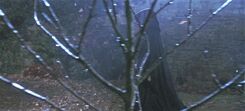
Voldemort wearing a hooded cloak during the First War, as a possible means to invoke fear
Voldemort devised a symbol called the Dark Mark which he magically branded onto the forearms of his followers, enabling him to summon them to his side. They began establishing relations with various kinds of dark creatures, including Giants and Werewolves. Though the Death Eaters were generally even less tolerant of them than wizarding society in general, these creatures were receptive of their violent and destructive goals. Dark activity throughout Britain rose, and Voldemort began surreptitiously killing poor and homeless Muggles (whose absences would not be noticed) with his followers so that he could reanimate their corpses with Necromancy until he had an army of Inferi.
In the wider British wizarding world, the early actions of the Death Eaters were almost totally unknown, and the 1960s were a time when the tide of social progress clashed with the entrenched social order. At some point around 1960, Scottish Magical Sports and Games advocate Magnus "Dent Head" MacDonald spearheaded a campaign against the Ministry's ban on the dangerous sport Creaothceann, which was enacted in 1762. Unfortunately, he was unsuccessful since the Ministry refused to lift it. In 1962, Minister for Magic Ignatius Tuft was forced out of office for promising to institute a controversial Dementor breeding programme for Azkaban. He was replaced by Nobby Leach, who became the first Muggle-born ever to hold the Minister position, leading senior members of the Wizengamot to resign in protest. In 1963, Muggle expert Mordicus Egg published The Philosophy of the Mundane: Why the Muggles Prefer Not to Know, which posited actual theories about why Muggles continued to be unaware of magic, rather than just assuming them to be stupid, ignorant beasts.[7]
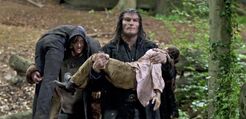
Savage werewolf Fenrir Greyback doing Voldemort's dirty work in exchange for victims
In March 1965, the werewolf Fenrir Greyback killed two Muggle children, avoided prosecution, and broke out of the Ministry of Magic. This led Department for the Regulation and Control of Magical Creatures employee Lyall Lupin to declare that werewolves were "soulless, evil, and deserving nothing but death", leading to the attack on and infection of his 5-year-old son Remus at the hands of an offended Greyback. Lupin and his Muggle wife Hope feared if Remus' inability to attend Hogwarts in such condition and tried to home-school him.[8] At the same time, the Ministry enacted a ban on the experimental breeding of dark or dangerous creatures written by famed Magizoologist Newton Scamander,
Between 1965 and 1971[9], Dumbledore, who was noted as a social progressive believing strongly in the rights of Muggles as well as Muggle-borns and other oppressed minorities, ascended to the post of Headmaster. Voldemort returned to Hogwarts to reapply for the position of Defence Against the Dark Arts professor. Unlike last time, it is unlikely that this desire was sincere, and his main goal was to search the castle for Godric Gryffindor's sword and turn it into his sixth Horcrux, which would complete his goal of splitting his soul into seven pieces. Unsurprisingly, Dumbledore declined to hire him. Perhaps out of spite for the Headmaster, Voldemort placed a jinx on the position, making it so a professor could not hold it for more than one school year.[3] Whatever the reason, this ended up having insidious benefits to his long-term plans, as decades of students (including many of his future enemies) would be stuck with erratic, poor-quality knowledge of Defence Against the Dark Arts.
While in the school, Voldemort also took the opportunity to conceal the diadem in the legendary Room of Requirement. He also hid the ring in the ruins of the Gaunt Shack in Little Hangleton and placed the locket in an inaccessible seaside cave he had visited in his youth with fellow orphans Amy Benson and Dennis Bishop, guarded by his Inferi and other enchantments. He entrusted the cup into the Gringotts vault of the pure-blood supremacist Lestrange family, as the elder Lestrange was one of his earliest followers whose sons, Rodolphus and Rabastan, and future daughter-in-law Bellatrix Black, a loyal member of the pure-blood supremacist House of Black, soon joined the cause. As for the diary, Voldemort kept it in his own possession. With his secret and safely-hidden Horcruxes insuring him against death and his power growing, the time for Voldemort to carry out his plans grew near.
In 1968, Nobby Leach left office for mysterious health reasons, leading to a conspiracy theory that he had been poisoned by his Muggle-prejudice advisor Abraxas Malfoy, who shared his belief that Muggle-borns were unworthy to lead the wizarding community with his son Lucius.[10] He was replaced as Minister for Magic by Eugenia Jenkins, who, like her predecessor, was sympathetic to issues of social justice. Squibs began marching for their rights, which spurred pure-blood supremacists to riot. Throughout the decade, with various minority groups demanding to be treated as equals, many of the old, elite pure-blood houses, to which all of the Death Eaters belonged, increasingly felt that their very way of life was being threatened.[11] Many pure-blood supremacists who did not join the ranks of the Death Eaters nonetheless gave their wholehearted support to Voldemort's cause.
War
Dark Rebellion
- "Voldemort... this wizard, about twenty years ago now, started lookin' fer followers. Got 'em, too –– some were afraid, some just wanted a bit o' his power, 'cause he was gettin' himself power, all right. Dark days, Harry. "
- — Rubeus Hagrid regarding how the first war began[src]
It was in this charged climate that in 1970, Voldemort proclaimed himself the new Dark Lord. With his army of followers and Horcruxes as protection, he launched a revolution against the Ministry of Magic with the intention of toppling it and creating a new world order run by pure-bloods with Muggles kept in bondage and Lord Voldemort himself as the immortal ruler for all time. To achieve these ends, the Death Eaters and their allies (including the particularly destructive Giants) began openly carrying out attacks on Muggles for sport and to sow chaos. Cleaning up these attacks, healing survivors, modifying memories, searching for the perpetrators, and attempting to prevent future attacks occupied more and more of the Ministry's time and attention. As their confidence grew, they began targeting Muggle-born and Blood Traitor witches and wizards as well, torturing and sometimes killing their victims, which shocked wizarding society. Other "inferior" magical beings such as house-elves (who were treated like vermin) and Goblins (a family of which was slaughtered) also suffered under their reign of terror.
With many Death Eaters occupying strategic positions within the Ministry of Magic itself, they used blackmail and the Imperius Curse to expand their influence and destabilise the government, which was desperately trying to keep order and continue to maintain secrecy from the Muggle world. Augustus Rookwood, an Unspeakable in the Department of Mysteries, managed to set up a particularly successful network of espionage. Minister Jenkins was ill-prepared to lead during wartime, and it seemed that the Ministry was incapable of gaining the upper hand.
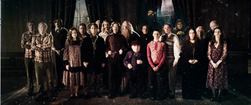
The original Order of the Phoenix
In response to the growing threat of Lord Voldemort and his minions, Albus Dumbledore formed the Order of the Phoenix to take the fight directly to the Death Eaters. Though the Ministry officially viewed the Order as a renegade outfit, a number of Ministry officials (such as Elphias Doge and the Aurors Alastor Moody and Frank and Alice Longbottom) joined to participate in more secretive, sudden assaults to crush the Dark Rebellion.[12] When Dumbledore helped black market trader Mundungus Fletcher out of trouble, he joined the Order and, due to his knowledge of the criminal underworld, proved useful. To allow members of the Order to covertly communicate with each other, Dumbledore invented a method of sending messages via the Patronus Charm.
But Dumbledore, came by their home and reassured them that the school would have a safe location for their son's monthly transformations.
Height of the War
- Remus Lupin: "The last time Voldemort had power he almost destroyed everything we hold most dear."
- Sirius Black: " Fourteen years ago he had huge numbers at his command — not just witches and wizards but all manner of Dark creatures."
- — Conversation regarding the height of the war[src]
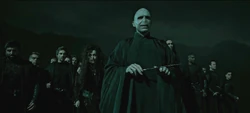
Voldemort and his Death Eaters followers at the height of the war
The nascent Order initially had very little success, and terror and chaos gripped the populace of wizarding Britain to the point that many began to fear to speak Voldemort's name. He became widely referred to as "He Who Must Not Be Named," or, less formally, "You Know Who". Numerous ordinary witches and wizards (such as Mr Thomas and Robert McGonagall Jr) lost their lives, and the Death Eaters frequently cast the Dark Mark over the scenes of their murders. To protect the organisation, Voldemort ensured that Death Eaters did not know the identities of too many of their fellows, and, to society at large, their identities were completely unknown.[13] Increasing the confusion and paranoia even further, they often placed innocent victims under the Imperius Curse and forced them to carry out their dirty work. Even friends and family members were not above suspicion of one another.
In 1975, Eugenia Jenkins was ousted as Minister for Magic and replaced by Harold Minchum, a hardliner who placed more Dementors around Azkaban.[11] Ruthless Council of Magical Law judge Bartemius Crouch rose rapidly through the ranks until he became the Head of the Department of Magical Law Enforcement. Minchum and Crouch began to make headway, though the anonymous and elusive Death Eaters still retained the advantage.
In 1978, Severus Snape graduated from Hogwarts and entered the ranks of the Death Eaters, joining his schoolmates Evan Rosier, Avery, Mulciber and Wilkes. Likely at Snape's urging, Voldemort attempted to recruit Lily Evans, whose prodigious talents made up for her status as a Muggle-born, along with her Blood Traitor boyfriend James Potter. Naturally, they refused, defying Voldemort for the first time, and were soon married. Around this time, James and his best friend Sirius Black, who had been disowned by the House of Black, were pursued by a trio of Death Eaters.[14] Though they managed to escape, this incident contributed to them joining the Order of the Phoenix, along with Lily and their friends Remus Lupin and Peter Pettigrew.
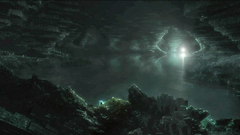
The cave where Voldemort hid his locket Horcrux
Voldemort gravitated towards several of his younger recruits who were magically powerful and fanatically loyal. He took Bellatrix Lestrange under his wing, sharing with her his knowledge of the Dark Arts and inspiring in her a delusional attraction bordering on obsession. He entrusted his diary to Lucius Malfoy, with which he schemed of using to reopen the Chamber of Secrets, for he did not dare attack Hogwarts directly with Dumbledore as Headmaster. This did not come to fruition till many years later. Severus Snape, a fellow Half-blood with whom he had much in common, became one of his most trusted lieutenants.
Skirmish at the Horcrux cave
In 1979, Regulus Black, the younger brother Sirius Black, graduated from Hogwarts and joined the Death Eaters. He remained a pure-blood supremacist, but quickly became disenchanted with the cause's insane and brutal leader. Around this time, Voldemort felt the need to test the defences around his Horcruxes. To make sure Slytherin's locket was secure, he requested the use of Regulus's house-elf Kreacher and then callously left him to die. When Kreacher managed to return home, Regulus deduced that Voldemort had created a Horcrux and attempted to destroy it. This failed and resulted in his violent death at the hands of the Inferi, though he did manage to replace the locket with a fake and entrust the real Horcrux to Kreacher.[15]
Despite being in the midst of a war, life went on for those who had not yet become its victims. Under the leadership of Dumbledore, Hogwarts remained a bastion of magical education. It was suggested after the war that marriages and births increased significantly during these years, as the future was uncertain.[15] Late in July of 1980, Order members James and Lily Potter had a son, Harry, while Frank and Alice Longbottom had Neville. At the same time, Death Eater Lucius Malfoy and his wife Narcissa had Draco, while Crabbe, Goyle, and Nott also had sons.
Barty Crouch's edict
In 1980, Minister Minchum was removed from office due to his failure to end the war was and replaced with Millicent Bagnold.[11] Order member Peter Pettigrew was secretly initiated as a Death Eater and began feeding information on the Order's movements to Voldemort. Members began regarding each other uneasily, and Sirius Black suspected that his friend Remus Lupin, who was frequently undercover among the werewolves, was a spy.[16] When the entire order gathered for a group photograph in July 1981, no one suspected the truth. Shortly afterwards, due to Pettigrew's betrayal, Death Eaters began murdering Order members and the war entered its most desperate phase. Marlene McKinnon was slaughtered alongside her entire family by Travers and several accomplices. Edgar Bones, his wife, and their children were murdered. Fabian and Gideon Prewett fought bravely but were ultimately killed by a group of Death Eaters led by Antonin Dolohov. Dorcas Meadowes was murdered by Voldemort himself. Caradoc Dearborn disappeared and was never found, though he was presumed dead. Benjy Fenwick was killed and so brutally mutilated that only bits of him were recovered.[12]

Igor Karkaroff under arrest and in Ministry custody
In response to this brutal onslaught, Barty Crouch issued an edict giving Aurors permission to employ the Unforgivable Curses against their enemies. They initially focused their efforts on resisting the giants, killing many of them and wiping out entire tribes until they forced the survivors to go into hiding.[12] Finally, the Ministry began to identify and apprehend Death Eaters. Auror and Order member Alastor Moody became legendary for his successes, arresting Igor Karkaroff along with many other supporters of the Dark Lord, and killing Evan Rosier when he resisted arrest, although losing a chunk of his nose in the process. Wilkes also met his death at the hands of Magical Law Enforcement and Antonin Dolohov, one of Voldemort's earliest followers, was captured and sent to Azkaban.
The Prophecy and the Fall of the Dark Lord
- "The one with the power to vanquish the Dark Lord approaches... born to those who have thrice defied him, born as the seventh month dies... and the Dark Lord will mark him as his equal, but he will have power the Dark Lord knows not... and either must die at the hand of the other for neither can live while the other survives..."
- — The prophecy of Voldemort's fall[src]

Harry Potter as an infant with his late parents
During the worst days of the war, James and Lily Potter lived in Godric's Hollow with their son, Harry. James lent his family heirloom invisibility cloak to Dumbledore, who was curious about its properties. Around this time, Dumbledore met with Sybill Trelawney at the Hog's Head Inn in Hogsmeade regarding the vacant position of Divination professor. During the interview, she made a prophecy about a person who would have the ability to defeat Lord Voldemort. There were two possible candidates, both born in July of 1980 to members of the Order of the Phoenix who had thrice defied the Dark Lord: Harry Potter and Neville Longbottom.[12] Severus Snape snuck into the tavern and managed to overhear only part of the prophecy before being thrown out by the tavern keeper and Order member Aberforth Dumbledore. He immediately reported what he had heard to Voldemort, who was greatly concerned over the information. He assumed that it meant the Potters' son (a half-blood like himself) and resolved to kill the infant. Dumbledore hired Trelawney so that she would be safe from Voldemort and his Death Eaters.

Voldemort arrives at Godric's Hollow intending to murder infant Harry
Complicating Voldemort's plan, Snape still harboured love for Lily Potter, enough that he covertly defected to the Order of the Phoenix so he could tell Dumbledore that Voldemort had marked her and her family for death.[15] Dumbledore bade the Potters to go into hiding under the protection of the Fidelius Charm. While James and Lily wanted Sirius Black to be their Secret-Keeper, because he was their closest and most trusted friend, it was for exactly those reasons that Black claimed that he was to obvious a choice and that Voldemort would suspect him. Instead, he suggested Peter Pettigrew, a "weak, talentless thing" who no one would ever expect. Thus, the real traitor became the Potters' Secret-Keeper, though no one (not even Dumbledore or Lupin) knew of the switch, and within a week he told his master the Potters' location.[16] Meanwhile, Dumbledore discovered that James's invisibility cloak was in fact the Cloak of Invisibility, the third of the legendary Deathly Hallows.

Voldemort murdering Lily Potter as she refuses to stop protecting her son
On 31 October, 1981, Voldemort travelled to the Potters in Godric's Hollow. He switftly murdered James, who was unarmed, but offered Lily a chance to save herself if she stepped away from the crib containing her infant son, as Snape had requested that she be spared. Lily refused and Voldemort murdered her before using the Killing Curse on Harry. However, Lily's loving sacrifice gave her son the protection of an ancient magic and the curse backfired, destroying Voldemort's physical body and leaving a lightning-shaped scar on Harry's forehead that a fragment of Voldemort's soul became attached to, inadvertently making Harry a Horcrux.[15]
The Boy Who Lived
- "To Harry Potter — the boy who lived!"
- — Celebrations going on at the end of the war and the destiny forced upon the young Harry Potter[src]
Although Voldemort's body was destroyed, he did not die because of his years of preparation and his Horcruxes enabled him to survive, albeit as a powerless mangled soul. He fled the collapsing house and the country, unable to be seen in such a weakened state. Hagrid arrived on Dumbledore's orders to rescue Harry from the cottage ruins with unexpected help from Black, who became aware of Pettigrew's treachery after finding his hovel empty with little sign of a struggle. Failing to convince Hagrid to give him Harry (since he was named the boy's guardian at the event of James and Lily's deaths), Black lent the half-giant his flying motorbike to carry the baby on for the journey to meet with Dumbledore. That night, news of Voldemort's downfall and apparent death spread like wildfire, with celebrations breaking out all across the country so strenuously that numerous large-scale breaches of the International Statute of Wizarding Secrecy were noticed by the Muggle media. This was excused by Minister Bagnold, who asserted the war-weary wizarding community's "inalienable right to party."
Harry Potter is delivered to 4 Privet Drive by Hagrid
Touted as "The Boy Who Lived", Harry Potter's status as the first person ever to survive the Killing Curse and the reason for Voldemort's downfall led to him becoming a world famous household name overnight. However, he was also an orphan, so Hagrid took him to the Surrey town of Little Whinging, where Dumbledore and Minerva McGonagall were waiting. They left Harry at the doorstep of 4 Privet Drive, the residence of his maternal aunt Petunia Dursley and her husband Vernon. Dumbledore left a note with him explaining the circumstances to the Dursleys, most importantly that they must allow Harry to grow up in their home and return there once a year in order to ensure that his mother's protection would continue working, as he knew that Voldemort would someday return and that Harry would be in danger. Order member Arabella Figg, who lived several streets down, accepted the task of keeping watch over Harry and the Dursleys.
Decline of the Death Eaters
- "The Dark Lord will rise again, Crouch! Throw us into Azkaban; we will wait!"
- — Bellatrix Lestrange's parting words at her trial[src]
In the aftermath of Voldemort's shockingly abrupt defeat and subsequent disappearance without a trace, many were sceptical that he was really dead. Aurors searched at home and abroad for any sign of him. Although they eventually came to the conclusion that Voldemort had truly been defeated, many Death Eaters were still at large.

Dolohov in his high-security cell in Azkaban
Having retrieved his master's wand from the destroyed Potter Cottage, Pettigrew attempted to go into hiding with it the next day in fear of being perceived a traitor by the Death Eaters (since his information caused Voldemort's downfall), but was confronted by Black on a London street. In order to escape, he used the recovered wand to conjure a powerful Blasting Curse that killed twelve Muggle bystanders and transformed into his Animagus form of a rat, leaving behind a severed index finger as evidence against his opponent. This left Black universally perceived as the traitor and a mass murderer, for which he was quickly arrested and carted off to Azkaban without a trial, while Pettigrew was universally left for dead and unjustly awarded the Order of Merlin (First Class) for his supposed willingness to stand up for the safety of a friend.[16] Other actual Death Eaters like Travers, Mulciber and three others who helped murder the Boneses, were likewise captured and imprisoned, while Dumbledore gave testimony exonerating Snape, who he hired as Potions professor to replace the retiring Slughorn. Fenrir Greyback and the other werewolves went back underground, and the few remaining Giants left the British Isles entirely and resettled in the last remaining Giant colony in the world.[12]
The imprisoned Karkaroff gave up Rookwood, who was thrown into Azkaban, in exchange for his freedom, which he used as an opportunity to flee the country and eventually gain employment as a professor at Durmstrang Institute. The subsequent investigation of Rookwood's spy network led to numerous individuals being questioned (including Ludovic Bagman, Beater for the Wimbourne Wasps, who was found not guilty).[13] Despite the Ministry crackdown, many Death Eaters were able to walk free. Many innocent people were released from the Imperius Curse following Voldemort's defeat, so some of them used this as an excuse. Others simply used their wealth, power, and influence to avoid punishment for their crimes. Lucius Malfoy, Corban Yaxley, Amycus and Alecto Carrow, Walden Macnair, Gaspar Avery, Francis Crabbe, Goyle and Nott were officially considered innocent in the years after the war. Assuming that Voldemort was dead and gone, they simply carried on with their daily lives.
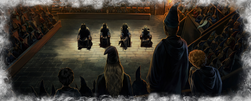
Rodolphus, Bellatrix, Rabastan, and Barty Crouch Jr, tried before the Council of Magical Law
However, not all Death Eaters were content to give up Voldemort's cause. Bellatrix, Rodolphus, and Rabastan Lestrange, along with Crouch's own son, Bartemius Crouch Jnr, abducted and interrogated Frank and Alice Longbottom. Believing that they had information on Voldemort's whereabouts, they tortured them with the Cruciatus Curse so severely that they were left permanently and mentally disabled. After the Death Eaters were arrested, the Longbottoms were moved to St Mungo's Hospital for Magical Maladies and Injuries for long-term care and their infant son Neville was raised by his grandmother Augusta Longbottom. The horrific attack enraged the public, and Bartemius Crouch Snr sentenced them all, including his son, to life in Azkaban. Bellatrix proudly proclaimed her loyalty and declared that the Dark Lord would return as they were dragged away by the Dementors.[13]
Aftermath

Lord Voldemort in exile
Now stripped of almost all magical abilities, Voldemort eventually made his way to Albania, where he started haunting the remote forest he visited years earlier. There, he tried to gain physical form by briefly possessing the bodies of snakes, which only reduced their lifespan due to them being ill-equipped to perform magic. Any help he possibly had in order to potentially render himself mostly required the use of a wand, yet it was not optional for Voldemort to enter the outside world and possess humans, for he was aware that the Aurors were still abroad in search for any sign of him. So he waited, desperately hoping that one of his faithful followers would find him and restore him to power.
Having hidden Voldemort's wand to prevent it from falling into Ministry hands, Pettigrew scurried all the way to Devon, where he was taken in by the blood-traitorous Weasley family through their third oldest son Percy Weasley as a pet named "Scabbers". This enabled the rat to stay aware of magical current events until hearing any rumour of the Dark Lord rebuilding his power, which would thus make it safe for Pettigrew to return to him. It was made clear to the Weasleys that Scabbers was very extraordinary; since all rats of his species had a life expectancy of three years, they continued owning him for much longer up to the point where he was inherited by their youngest son Ron Weasley. Because Ron would later become best friends with Harry Potter at Hogwarts, Pettigrew saw his opportunity to capture and deliver the Boy Who Lived to Voldemort as a welcome-back gift, as well as dissuading his fellow Death Eaters from ever daring to claim him a traitor. But he never took action in doing so immediately without certain assurances, for he knew Voldemort was no longer strong enough to protect him.
At his dying wife's request, Bartemius Crouch Snr orchestrated the first assisted escape from Azkaban to save his son from a life imprisonment. He accomplished this by having mother and son switch appearances via Polyjuice Potion, at which point he left with his son while his wife stayed behind. Crouch used the Imperius Curse and an invisibility cloak to imprison his son in their home under the constant care of his house-elf Winky. After his "son" died in Azkaban, he also faked the death of his wife to uphold the deception. With the war over, the public began to reexamine Crouch's relationship with his son, and his reputation took a major hit. Whereas it had been anticipated that he would replace Millicent Bagnold as Minister for Magic, his meteoric political career was effectively ended, and he was demoted to Head of the Department of International Magical Cooperation. His son, meanwhile, grew increasingly insane and fanatical the longer he was imprisoned.
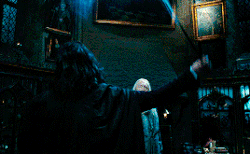
Snape's continuing love for Lily Evans, years after her death and vowing to protect her son
With dark forces having terrorised the wizarding communities of Great Britain for over a decade, claimed numerous victims, and scarred, bereaved, and traumatised countless others, the survivors of the war began to rebuild. The spectre of Lord Voldemort, who had supplanted Grindelwald as the most dangerous Dark Wizard of the 20th century, still held a terrible influence, as the widespread fear of the sound of his name continued even over a decade after his downfall. The horrifying idea that he had not truly been defeated lingered, though it was largely eclipsed by the vehement insistence that he was dead and would never come back, a belief maintained by many witches and wizards, including Cornelius Fudge, who would become the next Minister for Magic. However, Albus Dumbledore and his supporters from the now disbanded Order of the Phoenix knew that Voldemort would return. As a precaution, he contacted his friend Nicolas Flamel, who agreed to lock up the Philosopher's Stone, one of the few methods by which Voldemort could regain his power, in a Gringotts vault.[4] Severus Snape vowed that he would protect Harry Potter at all costs, as the boy was destined to defeat the Dark Lord once and for all.[15]
Behind the scenes
- Since both this conflict and The Second Wizarding War took place mainly in Britain, with British wizards fighting British wizards, then both wars were technically civil wars, similar to the War of The Roses.
Media
Template:VideoFooter
Appearances
- Harry Potter Prequel
- Harry Potter and the Philosopher's Stone (First appearance)
- Harry Potter and the Philosopher's Stone (film)
- Harry Potter and the Chamber of Secrets (Indirect mention)
- Harry Potter and the Prisoner of Azkaban (Indirect mention)
- Harry Potter and the Goblet of Fire (Appears in flashback(s))
- Harry Potter and the Goblet of Fire (film) (Appears in flashback(s))
- Harry Potter and the Order of the Phoenix (Appears in flashback(s))
- Harry Potter and the Order of the Phoenix (film) (Indirect mention)
- Harry Potter and the Half-Blood Prince (Indirect mention)
- Harry Potter and the Deathly Hallows (Appears in flashback(s))
- Harry Potter and the Deathly Hallows: Part 1 (Appears in flashback(s))
- Harry Potter and the Deathly Hallows: Part 2 (Appears in flashback(s))
- Harry Potter and the Cursed Child
- The Tales of Beedle the Bard (Indirect mention)
- Pottermore
See also
Notes and references
- ↑ Pottermore - From the Story: Evan Rosier
- ↑ Harry Potter and the Chamber of Secrets
- ↑ 3.0 3.1 Harry Potter and the Half-Blood Prince
- ↑ 4.0 4.1 Harry Potter and the Philosopher's Stone
- ↑ Harry Potter and the Prisoner of Azkaban, Chapter 18 (Moony, Wormtail, Padfoot and Prongs)>Hepzibah died ten years before Voldemort met with Dumbledore. Lupi, born 1960, was bitten near his fifth birthday in 1965 and his quote in PoA tell us Dumbledore became Headmaster after this, between 1965 and 1971, meaning Hepzibah died between 1955 and 1961
- ↑ Bloomsbury Live Chat
- ↑ Fantastic Beasts and Where to Find Them
- ↑ Writing by J. K. Rowling: "Remus Lupin" at Pottermore
- ↑ Harry Potter and the Prisoner of Azkaban, Chapter 18 (Moony, Wormtail, Padfoot and Prongs) Remus Lupin says - "“I was a very small boy when I received the bite...But then Dumbledore became Headmaster, and he was sympathetic." According to Writing by J. K. Rowling: "Remus Lupin" at Pottermore , Remus Lupin became a werewolf shortly before he turned 5 in March 1965 and Dumbledore visited him as Headmaster shortly before his eleventh birthday. This means Dumbledore became Headmaster between March 1965 and March 1971.
- ↑ Writing by J. K. Rowling: "The Malfoy Family" at Pottermore
- ↑ 11.0 11.1 11.2 Writing by J. K. Rowling: "Ministers for Magic" at Pottermore
- ↑ 12.0 12.1 12.2 12.3 12.4 Harry Potter and the Order of the Phoenix
- ↑ 13.0 13.1 13.2 Harry Potter and the Goblet of Fire
- ↑ Harry Potter Prequel
- ↑ 15.0 15.1 15.2 15.3 15.4 Harry Potter and the Deathly Hallows
- ↑ 16.0 16.1 16.2 Harry Potter and the Prisoner of Azkaban


